Expression of hepatitis C virus proteins induces distinct membrane alterations including a candidate viral replication complex
- PMID: 12021330
- PMCID: PMC136238
- DOI: 10.1128/jvi.76.12.5974-5984.2002
Expression of hepatitis C virus proteins induces distinct membrane alterations including a candidate viral replication complex
Abstract
Plus-strand RNA viruses characteristically replicate their genome in association with altered cellular membranes. In the present study, the capacity of hepatitis C virus (HCV) proteins to elicit intracellular membrane alterations was investigated by expressing, in tetracycline-regulated cell lines, a comprehensive panel of HCV proteins individually as well as in the context of the entire HCV polyprotein. As visualized by electron microscopy (EM), expression of the combined structural proteins core-E1-E2-p7, the NS3-4A complex, and protein NS4B induced distinct membrane alterations. By immunogold EM (IEM), the membrane-altering proteins were always found to localize to the respective altered membranes. NS4B, a protein of hitherto unknown function, induced a tight structure, designated membranous web, consisting of vesicles in a membranous matrix. Expression of the entire HCV polyprotein gave rise to membrane budding into rough endoplasmic reticulum vacuoles, to the membranous web, and to tightly associated vesicles often surrounding the membranous web. By IEM, all HCV proteins were found to be associated with the NS4B-induced membranous web, forming a membrane-associated multiprotein complex. A similar web-like structure in livers of HCV-infected chimpanzees was previously described (Pfeifer et al., Virchows Arch. B., 33:233-243, 1980). In view of this finding and the observation that all HCV proteins accumulate on the membranous web, we propose that the membranous web forms the viral replication complex in HCV-infected cells.
Figures

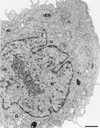
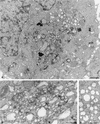
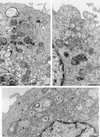

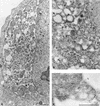
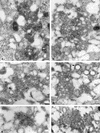

Similar articles
-
Three-dimensional architecture and biogenesis of membrane structures associated with hepatitis C virus replication.PLoS Pathog. 2012;8(12):e1003056. doi: 10.1371/journal.ppat.1003056. Epub 2012 Dec 6. PLoS Pathog. 2012. PMID: 23236278 Free PMC article.
-
Glycine Zipper Motifs in Hepatitis C Virus Nonstructural Protein 4B Are Required for the Establishment of Viral Replication Organelles.J Virol. 2018 Jan 30;92(4):e01890-17. doi: 10.1128/JVI.01890-17. Print 2018 Feb 15. J Virol. 2018. PMID: 29167346 Free PMC article.
-
Morphological and biochemical characterization of the membranous hepatitis C virus replication compartment.J Virol. 2013 Oct;87(19):10612-27. doi: 10.1128/JVI.01370-13. Epub 2013 Jul 24. J Virol. 2013. PMID: 23885072 Free PMC article.
-
Hepatitis C virus RNA replication.Curr Top Microbiol Immunol. 2013;369:167-98. doi: 10.1007/978-3-642-27340-7_7. Curr Top Microbiol Immunol. 2013. PMID: 23463201 Free PMC article. Review.
-
Membrane association of hepatitis C virus nonstructural proteins and identification of the membrane alteration that harbors the viral replication complex.Antiviral Res. 2003 Oct;60(2):103-9. doi: 10.1016/j.antiviral.2003.08.017. Antiviral Res. 2003. PMID: 14638405 Review.
Cited by
-
Innate immune responses in hepatitis C virus infection.Semin Immunopathol. 2013 Jan;35(1):53-72. doi: 10.1007/s00281-012-0332-x. Epub 2012 Aug 7. Semin Immunopathol. 2013. PMID: 22868377 Free PMC article. Review.
-
Hepatitis C virus comes for dinner: How the hepatitis C virus interferes with autophagy.World J Gastroenterol. 2015 Jul 28;21(28):8492-507. doi: 10.3748/wjg.v21.i28.8492. World J Gastroenterol. 2015. PMID: 26229393 Free PMC article. Review.
-
Intragenic complementation of hepatitis C virus NS5A RNA replication-defective alleles.J Virol. 2013 Feb;87(4):2320-9. doi: 10.1128/JVI.02861-12. Epub 2012 Dec 12. J Virol. 2013. PMID: 23236071 Free PMC article.
-
Hepatitis C virus activates Bcl-2 and MMP-2 expression through multiple cellular signaling pathways.J Virol. 2012 Dec;86(23):12531-43. doi: 10.1128/JVI.01136-12. Epub 2012 Sep 5. J Virol. 2012. PMID: 22951829 Free PMC article.
-
Chemical combinations elucidate pathway interactions and regulation relevant to Hepatitis C replication.Mol Syst Biol. 2010 Jun 8;6:375. doi: 10.1038/msb.2010.32. Mol Syst Biol. 2010. PMID: 20531405 Free PMC article.
References
-
- Aldabe, R., and L. Carrasco. 1995. Induction of membrane proliferation by poliovirus proteins 2C and 2BC. Biochem. Biophys. Res. Commun. 206:64-76. - PubMed
-
- Barba, G., F. Harper, T. Harada, M. Kohara, S. Goulinet, Z. Matsuura, G. Eder, Z. Schaff, M. J. Chapman, T. Miyamura, and C. Bréchot. 1997. Hepatitis C virus core protein shows a cytoplasmic localization and associates to cellular lipid storage droplets. Proc. Natl. Acad. Sci. USA 94:1200-1205. - PMC - PubMed
-
- Bartenschlager, R., and V. Lohmann. 2000. Replication of hepatitis C virus. J. Gen. Virol. 81:1631-1648. - PubMed
-
- Bienz, K., and D. Egger. 1995. Immunocytochemistry and in situ hybridization in the electron microscope: combined application in the study of virus-infected cells. Histochem. Cell Biol. 103:325-338. - PubMed
Publication types
MeSH terms
Substances
LinkOut - more resources
Full Text Sources
Other Literature Sources
Medical
Molecular Biology Databases
Research Materials

